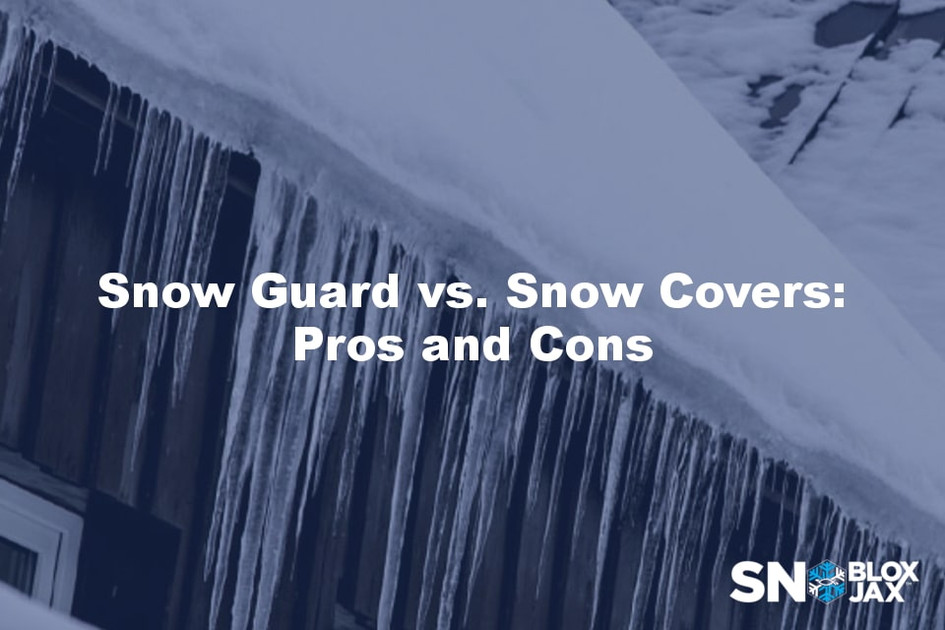Snow Guard vs. Snow Covers: Pros and Cons
Posted by SnoBlox-Snojax on Nov 18th 2021
In areas of the country where snow and ice are common winter occurrences, homeowners have to pay special attention to their metal roofs. If you don’t take proper precautions, you could end up suffering from a dangerous rooftop avalanche. These heavy, sliding sheets of snow crush everything in their path, including gutters, vehicles, and any people unfortunate enough to be around.
Even if there is no immediate damage, the piling drifts of snow can lead to damage to your home’s walls and foundation as the snow melts into water. The weight of the gathering snow can also cause sagging and damage to your roof, gutters, and skylights.
You can protect your home from rooftop avalanches and sagging by investing in the proper snow retention system.
What Are Snow Guards?
Snow guards are devices that are installed on your rooftop to prevent snow from sliding off your roof suddenly. Instead, snow guards help ice and snow melt completely and drift off the roof gradually.
There are different types of snow guards and snow guard accessories made from different materials including metal and polycarbonate. They can be installed either with a clamp or with adhesive. Different designs and installation methods were created with different types of metal roofs in mind. Before you buy and install snow guards, make sure that you are choosing the correct type for your roof.
What Are Snow Covers?
Snow covers are, much as the name suggests, covers for your roof meant to protect them from snowfall. They are much like large tarps and can help improve insulation, aid snowmelt, and protect your roof from water damage.
Snow covers come in many sizes, shapes, and colors. If you have a large roof or a complex roof design, you may need more than one to cover your roof completely.
Should I Use a Snow Cover or a Snow Guard?
While both snow guards and snow covers serve their purpose, the best snow protection and retention system for your roof will depend on a number of factors, including:
- The size of your house
- The average amount of snowfall in your area
- The material of your roof
Installation
Snow guards can be installed almost any time of the year. We recommend installing them before winter hits to avoid having to brush down snow and ice for installation. If there is a lot of snow already on the roof, or if the temperatures are sub-freezing, we don’t recommend attempting installation for your own safety.
Snow covers, on the other hand, should be installed right before the first snowfall. This can be difficult to predict, and if the weather surprises you, you may end up not being able to install them at all.
Snow covers also take much longer to install than snow guards. You have to cover the entire roof and ensure that they are tied down securely. Snow guards are relatively quick and easy to install by comparison. Even if you are installing additional snow guard accessories, the time involved should be less than half that for snow cover installation.
Protection and Safety
Snow covers are meant to protect your roof from leaks and water damage. Creating a smooth surface can also encourage snow to slide off rather than build up. However, after you install your snow covers, you’ll have to check in frequently to ensure that snow is not building up. If snow and ice build up on your snow cover, the slick surface may make a rooftop avalanche more likely instead of less. For this reason, snow covers are best used in areas where there is little snowfall (a few inches per season), and the main concerns are leaks, water damage, and insulation.
In areas with several feet of snowfall, snow guards are the best protection against rooftop avalanches and the damage they can cause. They retain snow, aid melt, and guide snow safely off your roof. With the right snow guard accessories, you can also protect your vent pipes, chimneys, and masts from snow and ice damage.
Maintenance
Snow covers require little maintenance, but they may need to be replaced annually, depending on the material and the harshness of the winter. These covers can also drastically reduce maintenance costs for your roof by limiting wear and tear and preventing water damage.
Snow guards should be checked every spring to ensure that they are in good working order. Guards fixed with adhesive usually last significantly less time than clamped models because the temperature fluctuations cause deterioration in the caulking. Clamped models can be left up all year round or removed in the spring and returned in the fall. Some homeowners prefer this method for aesthetic purposes. Clear, polycarbonate snow guards solve this problem because they are nearly invisible. Snow guards also significantly reduce maintenance costs for your roof, gutter, and surrounding landscape by diverting rooftop avalanches.
The best choice for you will depend on your roof’s design and your home’s location. If you have questions about how snow guards work, which snow guard accessories your roof may benefit from, or need help with installation, call SnoBlox-SnoJax at 717.963.2039.

